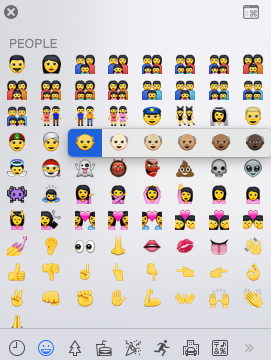 Users can now click and hold on the icon to change the skin tone on OS X 10.10.3 as well as iOS 8.3 beta 2. It is fun that we can now have Santa in different colors, and while general public celebrates the introduction of different type of family as advocating equal rights for LGBT families, Asian consumers are not too impressed with those 'ultra-yellow' emojis.
Users can now click and hold on the icon to change the skin tone on OS X 10.10.3 as well as iOS 8.3 beta 2. It is fun that we can now have Santa in different colors, and while general public celebrates the introduction of different type of family as advocating equal rights for LGBT families, Asian consumers are not too impressed with those 'ultra-yellow' emojis.A microbloggers wrote, "It looks like the yellow people have jaundice". The single post received thousands of likes on Chinese social media Weibo. Due to the long racist history of using "yellow" to describe Asians, many found the bright yellow tone uncomfortable or inaccurate. 'This can't be an Asian person', many said, and even more claimed that they are not inclined to use such emoji to describe themselves or their friends. (For more try weibo.com and search for a keyword combination of '苹果'-Apple,'表情' - Emoji, '黄'-yellow)
Regardless of the pathetic technical reasons that the yellow is simply brought by a standard set by UNICODE, what could we marketers learn from this unfortunate backfire when taking ethnical groups into account?
1. Don't think too highly of yourself.
It gets extremely complicated when marketing on a global scope - different cultures, different rituals, and different traps that you definitely hope to avoid. Your Asian friend might be okay with the super hilarious campaign to use in Taiwanese market - I personally very much enjoy the French comedy Qu'est-ce qu'on a fait au Bon Dieu? (Serial Bad Weddings) where a Chinese son-in-law is constantly laughed about trying too hard to please the in-laws, but the case would hardly be the same if the movie is to be broadcast over a Chinese national network. Take your time. Research your consumers. And be extremely generous when it comes to running tests on ethnical topics.
2. Monitor the social media your target actually use.
High conversion rate of Facebook Ads? Yes. Instagram great for luxury marketing? Yes. Your global consumers care about them? It depends. Line, Wechat, Kakao Talk, Weibo, and many other social platforms that I may have little knowledge of might be the center of world for your target consumers. If your new campaign has been retweeted thousands of times, try to get some sleep before you excitedly tell your colleagues several time zones away to work on it immediately. Those paying for your product might never own a Twitter account.
3. React. FAST.
No excuse to wait longer even if complaints are breaking out in another part of the earth. If negative comments appear, try to act as promptly as possible as if your boss is watching from your back. If the bright yellow color is a UNICODE default and not Apple's fault, let your consumers know. While I can find a detailed and convincing article explaining the yellowish color in English, I have yet to find any similar content in the Chinese world. And it has been FOUR DAYS since the initial controversy blurt out.

No comments:
Post a Comment